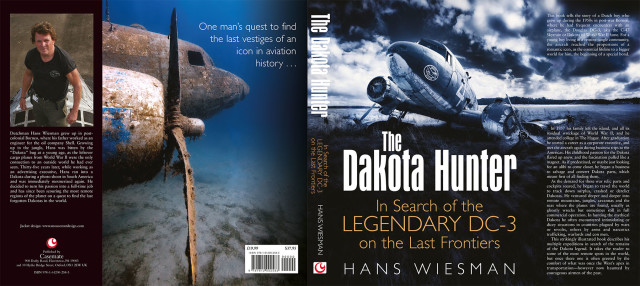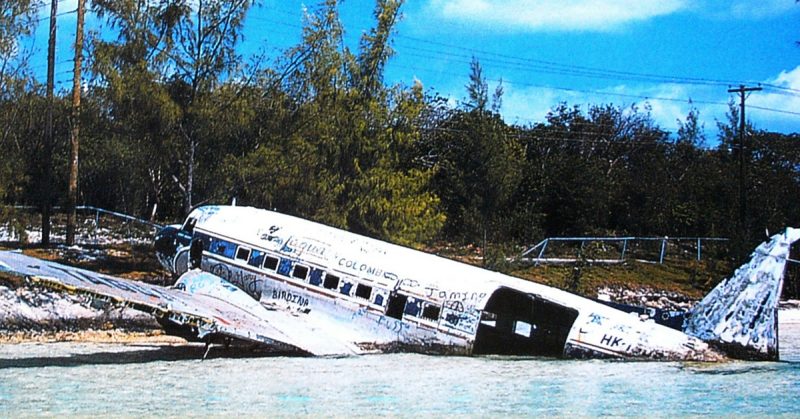In this DAKOTA HUNTER Blog you will find a series of amazing photos of Caribbean Drugs Runner aircraft that were left abandoned, crashed, seized or wrecked. From the earliest start of the illicit drugs trade from Central/ South America to the USA, aircraft played an important role in the transport. One of the first to exploit aircraft on a larger scale for such trade was Carlos Lehder, a car thief, a marijuana dealer, and smuggler from Medellin, Colombia. The tale of the modern day “Pirates of the Caribbean” is described in this Blog.
Along with his American companion George Jung, after his release from a US Federal Prison, Carlos Lehder started to think BIG in cocaine smuggling to the US mainland. By the late 1970’s, he took possession of a small Island in the Bahamas, named Norman’s Cay (with 100 houses, a marina, and a landing strip) by buying out or threatening out all residents of that island. With the bribing of State Officials and high ranking Police/ Customs Officers, the island soon turned into a drug smuggling hub and the private playground for the megalomaniacal Drugs Lord. A fleet of aircraft flew in at night from Colombia and the drugs were reloaded to smaller aircraft and General Aviation types for the final haul to Georgia, Florida, and the Carolinas.
He was a friend of that other legendary Medellin resident, Pablo Escobar, who helped him to handle every day some 300 kilos of cocaine to be transferred from Colombia to the USA via his little Treasure Island in which the Cartel Members thought to have found the fountain of Dazzling Wealth. For a smooth operation of all that trade, he even had extended the island’s airstrip to 3300 feet length in order to also land Jets! The business was booming, Money Galore, he became soon a Billionaire and started to bribe also Colombian Politicians who were preparing the procedure to extradite him to the USA. All the millions that he spent on that mission turned out to be wasted. He was finally sentenced to serve 55 years in a US prison (and he still is in jail) while most of his “Coca Cartel Compadres” followed soon or were killed in action.
Pablo Escobar, the King of Cocaine was shot and killed in Medellin during a manhunt in December 1993. The era of the great and conspicuously consuming Drugs Lords crumbled as the DEA , CIA and US Coast Guard stepped into the ring. But for at least another decade, the lesser Gods of Cocaine still found ways to get their trade into the USA by flying vintage aircraft into the islands of the Caribbean. Copy Cats but still running a most profitable business for sure, as the aircraft used were cheap to purchase all over the Americas. A US $ 150.000 price tag for a flying DC-3 was peanuts when considering the margins that were made on flying 3 tons of Cocaine closer to the USA and getting that stuff on the market. The profits made were so extravagant that even the occasional loss of a Dakota and a couple of Cessna 180s in the effort were easily accepted as “minor collateral damage”.
First time I came to the Bahamas was in the early 1990’s and found the remnants of that collateral damage all over the Caribbean. With wrecked, abandoned and crashed aircraft littered over the lagoons and beaches, those were fertile hunting grounds for the Dakota Hunter, in search of the legendary DC-3 (and its parts) at the last frontiers. Take a look at this collection of photos in this blog; it will give you some idea of the what happened out there in the wild years.
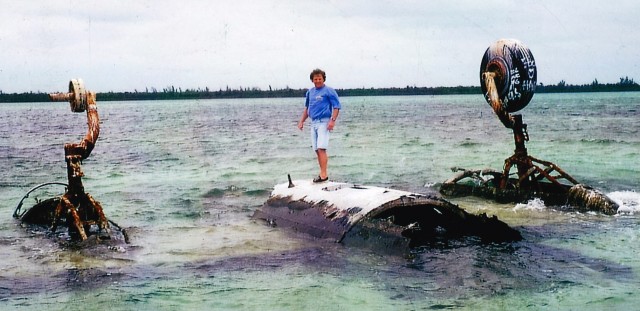
The photo above was taken in Bimini in 1995 or so. I stand here on top of a crashed Curtiss Commando C-46 that lays there since years, upside down in the shallow lagoon south of Bimini Island. According to local gossip, this aircraft tried to land on the tiny airstrip just next to the beach, with the idea to deliver the drugs at night to Go-Fast type Fishing boats. With 3 or 4 hefty 200 HP outboards lined up on their sterns, the “Sport-Fishing Boats “, hired in day-time for the Marlin Hunt, were waiting in the heat of the night to take over the stuff from the Colombian aircraft and cross the 50 miles distance between Florida and Bimini.
Their delicate cargo was to be delivered that same night in the creeks, remote beaches and rivers of Florida, where the trucks and vans waited for them. In my book The Dakota Hunter (see page 80-81), I describe in detail the fate of this aircraft, as it was likely intercepted by airborne patrol aircraft as the Lockheed P-3 Orions with a version of the AWACS system on board. The US Coast Guard had their patrol boats ready and the C-46 made a fatal overshoot in the panic after the pilots detected a “welcoming team”. In an effort to regain speed and escape, the aircraft must have banked to get away, entered into a stall, flipped over and crashed in the lagoon. (For more details of my book see below how to order from Amazon.)
Way back in the 1930’s, the lovely Island of Bimini was heavily involved in the smuggling of Alcohol. The drugs followed in the 1970’s and beyond. For some of the 600 residents, there was rarely a dull day, and the nights too must have been exciting for the hardworking fishermen. Bimini, a once-sleepy fishing resort in the Bahamas, had now morphed into a Mecca for gamblers.
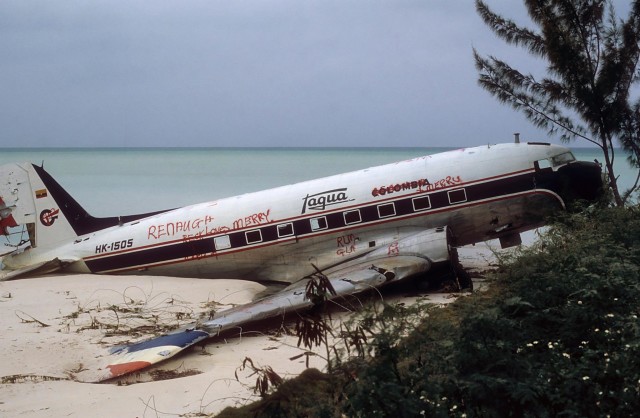
The above image and the featured photo of this Blog depict both the crashed Colombian DC-3 HK-1505 on a Caribbean Island’s beach. The aircraft used to be a decent Passenger/ Cargo hauler from Villavicencio/ Colombia, flying since some years in this Tagua livery. But one day, or better one night, she was spotted flying at very low altitude over the Caribbean sea from Northern Colombia to the Bahamas. The most probable scenario is that she was detected by an overhead flying US Patrol aircraft, like the P-3 Orion. That aircraft with an AWACS-like antenna dish on top of its fuselage had picked up the Dakota on her down looking radar or heat-detecting infrared camera. What happened often is that the pilots of the suspect plane were summoned to land on a major airport for a checkout. The pilots of this Tagua DC-3, like many other pilots of drug smuggling aircraft, opted instead to land in nearby shallow waters or on a beach, trying to escape their apprehension.
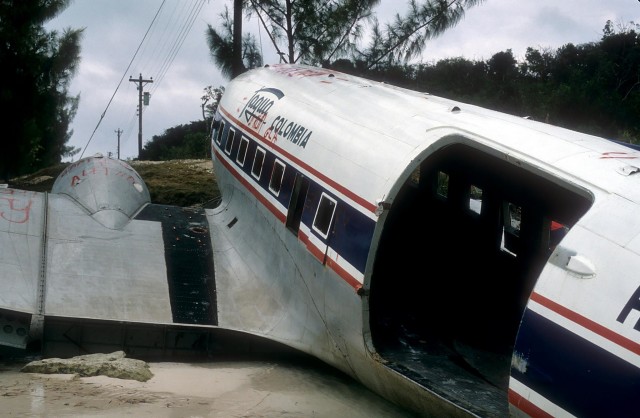
The photo above is the same Tagua DC-3 , with an empty cargo hold. Wonder what happened with that cargo? Were the US Coast Guard/ DEA/ Local agents or maybe the locals the first to arrive on this little Gold Mine? Engines were later taken off, always the most valuable part of a crashed Vintage aircraft that was built in WWII . According to my friend Michael Prophet, there is something weird in the way this aircraft was declared WFU or “Withdrawn from Use” at Villavicencio. That is what the “DC-3 Bible”, aka Air Britain 2006 publication says about this aircraft! Very unlikely indeed.
As I found out during my expeditions to the Amazon and Venezuela, it was not uncommon that certain DC-3s vanished, or were seized and ‘scrapped’ or declared WFU, while that very same aircraft a year later or so popped up with a new livery, registration number, and a different Manufacturer’s Plate/ Tag and Factory serial number riveted inside the cockpit. This “transforming” of airframes could well have been practiced in the drugs hauling circuit for obvious reasons to deceive the authorities. Worse, there were original/ legal owners, who lost aircraft in confiscations by the judicial authorities, accused of Drugs Trafficking. With no trials, the “distressed” aircraft vanished out of sight for a year, only to reappear with a new ID, now in hands of the same authorities that had seized the aircraft some years earlier. It is an Amazing World out there, I can tell you from my long time experiences and dealings that I did there during my expeditions to find the planes and the parts.
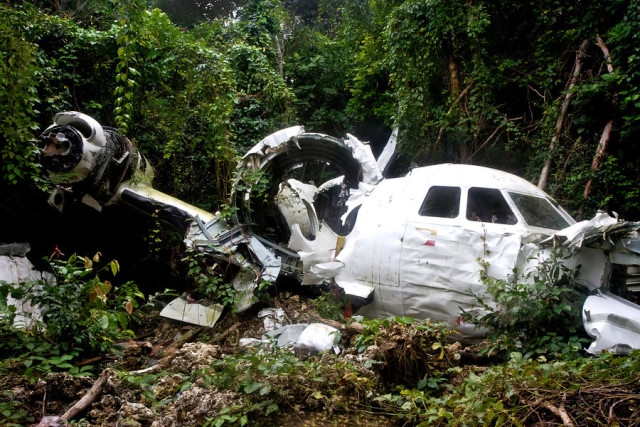
The photo above depicts a Jetstream 30 Twin Turboprop that crashed on the Honduran Island of Utila in 2009. The aircraft was spotted and being chased by DEA airborne patrol aircraft so the Military in Honduras knew about its nightly arrival on a remote abandoned strip for refueling. They had blocked the airstrip with trucks and as the aircraft ran out of fuel , it crashed in the adjacent jungle. 3 Colombians were found with their illicit cargo, 1.7 tons of cocaine. The pilot was killed in the accident, 2 others injured (Courtesy photo, Matthew Karsten http://expertvagabond.com/lost-colombian-drug-plane/)
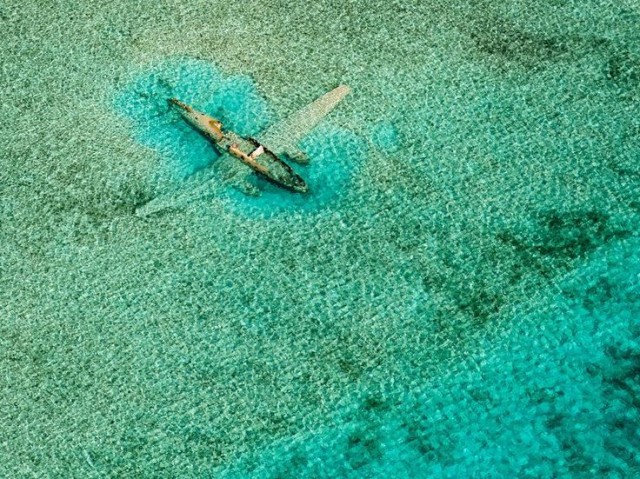
The photo above shows the decaying wreck of a Curtiss Commando C-46, most probably the aircraft located near Norman’s Cay. It is a snorkel divers paradise by now in the crystal clear shallow waters of the Bahamas.
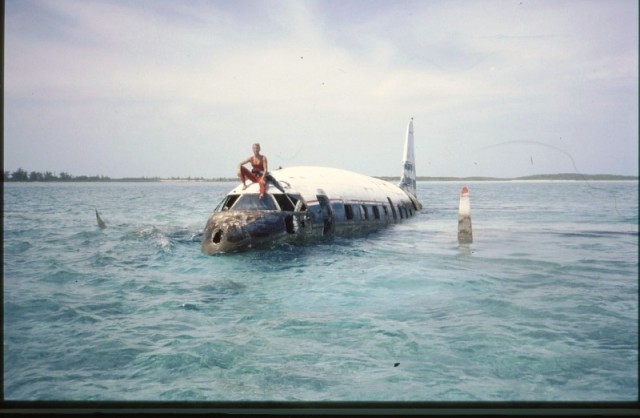
This photo shows what seems to be the same aircraft Curtiss Commando C-46.
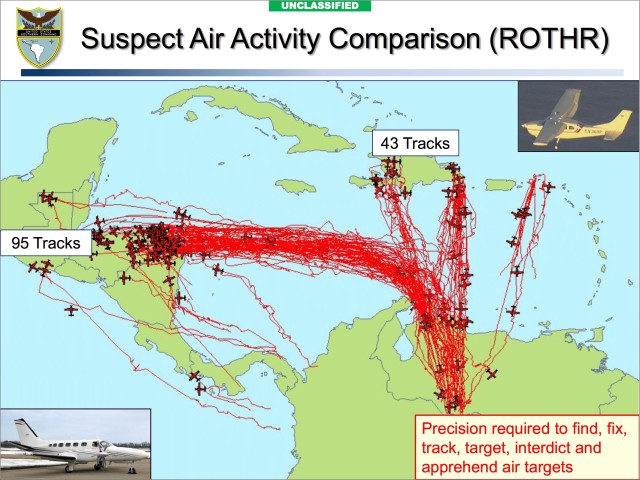
The photo above depicts a more recent mapping of drugs flights. With the demise of the flights from Colombia to the Bahamas due to a very strict airspace control and more grip on the airstrips in Northern Colombia, we see on this map the new approach of the Drugs Lords. The start of most drug flights has been relocated very clearly to Western Venezuela, close to the river Orinoco making the border between both countries.
The river port Puerto Ayacucho is since years one of the drug smuggling hubs, that were used also by FARC in its heydays for the smuggling of weapons and drugs. It was a No-Go area for me when I visited Colombia again in 2006 and many times after. Allegedly, even the legendary Presidente Hugo Chavez and his shadowy successor, President Maduro were/are involved in that trade.
Venezuela is a country in turmoil, with a serious power vacuum, and isolated from International Drugs fighting organizations as DEA etc. That is all fertile ground for Drugs smugglers who can easily bribe the authorities, being part of a Government that can barely pay the salaries of their agents and officials. Drugs from Colombia (likely, Venezuela produces now lots of home made drugs) are transported over that Jungle border river into Venezuela and flown mostly to Honduras, Dominican Republic and Haiti with all sorts of smaller aircraft. From there, it is another hurdle to get the stuff into the USA, but the Worlds largest Drugs Market is luring and makes the smugglers every time more inventive. Read how they manage to find new loopholes in a never ending struggle to stop the drugs trafficking into the USA.
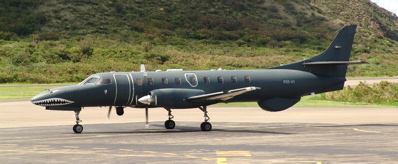
The photo shows a Swearingen C-26 twin turboprop, in black. With antennas all over, this is not a normal plane, but a very hefty spy plane that is involved in the modern aerial warfare against drugs smugglers hauling their trade in aircraft, Go-fasts, fishing boats or submarines. This plane flies about 240 knots in top speed but more important. it has a superb endurance that gives a loiter time for hours. With infrared cameras, she can pick up running engines from miles away, be it airborne, on or under water.
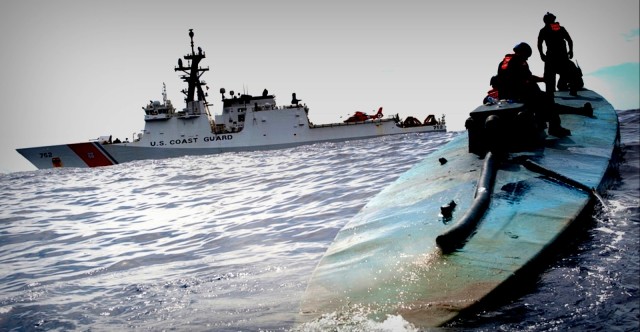
Photo above shows the apprehension of a Drugs Submarine by the US Coast Guard. The subs have grown over the past years from simple one-man torpedos to more complex vessels with a 3-4 crew on board and tons of Cocaine inside. Next to the semi-submerged boats propelled by “marinized” automotive engines, there is a new generation of real submarines, that have battery propulsion for totally submerged cruising.
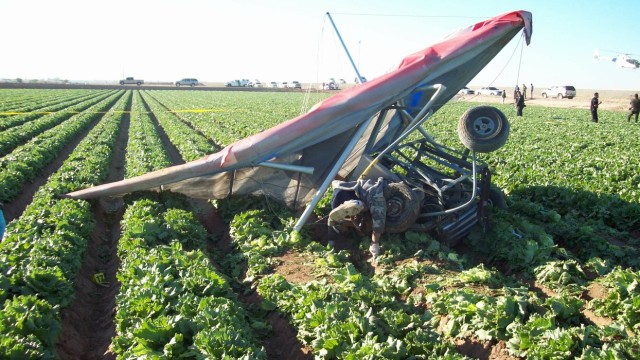
The photo above: With the intensified border patrols, walls and electric fences, there came the tunnels and later the airborne crossing of the Mexican-US border by Ultra Light aircraft at night. The drugs are slung underneath the aircraft in racks that can be dropped without a landing, in a zone where the pick-up will be arranged, just over the border. This particular Ultralight made a fatal crash landing in an Arizona field. Obviously, the poor night visibility had hidden the gutters in the field and the flight ended badly for the pilot.
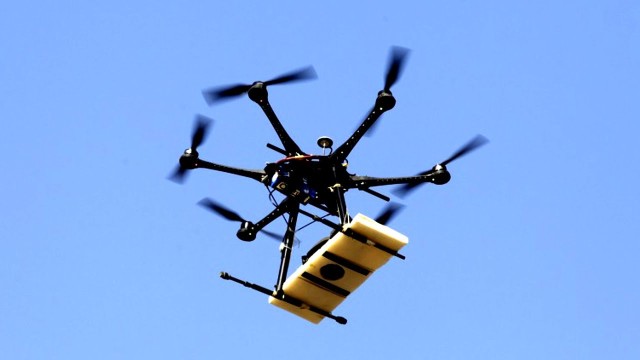
Photo above: The latest fad in cross-border drugs smuggling will surely come with this Radio Controlled Drone, delivering its parcels right on top of the roof of a house or in a truck. Very hard to detect by radar or infrared cameras, no/ low noise with electric motors, what is the next step that US Customs/ DEA will make to intercept this ? Jamming devices to interfere with the Drone’s radio frequencies or maybe even drone hunting drones? The good old days of the vintage Dakotas flying their illicit cargo into Bimini are long behind us, someway or another it seemed more romantic, but there is nothing idyllic about drugs smuggling.
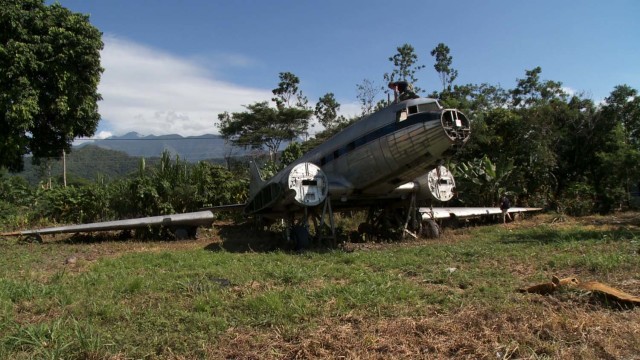
This photo above shows The Dakota Hunter crawling out of the cockpit roof hatch of this seized DC-3 in Villavicencio.
With all my adventures and encounters with the planes, pilots, the remote communities, the Military and the War/ Drugs Lords, I have collected my stories in a book of 320 pages, engagingly written and illustrated with 250 unique photos, of which you see a small number in this Blog. The book is titled The Dakota Hunter and describes my search of the abandoned, crashed or still flying Dc-3/ C-47, in remote places where the last of the WWII built aircraft still struggle for survival.
To order this book, you can go directly to the Amazon page by clicking here at Ordering at Amazon The Dakota Hunter Book. For 5-star reviews of my book The Dakota Hunter, scroll down on that Amazon page. For Previews and my earlier Dakota Hunter Blogs , click here at dc3dakotahunter.com.
Read one of my most successful Blogs here about the PBY-5 Catalina that I flew as a young kid over the Jungle and rivers of Borneo. Click Dakota Hunter Catalina Photo Album.
Enjoy, Hans Wiesman, author of The Dakota Hunter
Jacket design of my book shown below, Casemate Publishers USA/UK. ISBN 978-1-61200-258-3. Also available as “Autographed version”, see my website.
